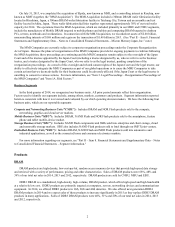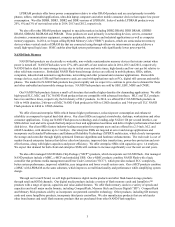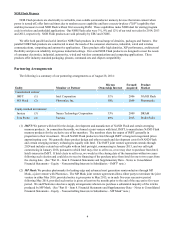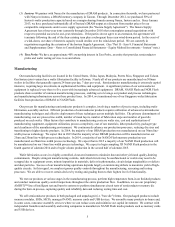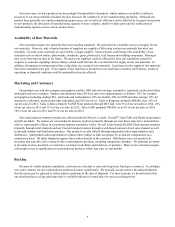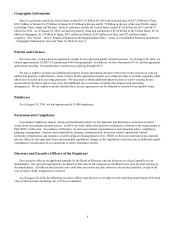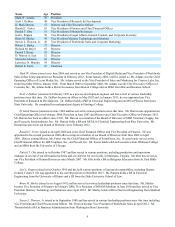Crucial 2014 Annual Report Download - page 14
Download and view the complete annual report
Please find page 14 of the 2014 Crucial annual report below. You can navigate through the pages in the report by either clicking on the pages listed below, or by using the keyword search tool below to find specific information within the annual report.12
Our Inotera Supply Agreement involves numerous risks.
We have a supply agreement with Inotera (the "Inotera Supply Agreement") under which we are obligated to purchase
substantially all of Inotera's DRAM output over an initial three-year term at a purchase price based on a discount from market
prices for our comparable components, currently through December 2016. The Inotera Supply Agreement contemplates annual
negotiations with respect to potential successive one-year extensions, and if the parties do not agree to an extension, the
agreement will terminate following the end of the then-existing term plus a subsequent three-year wind-down period. In the
event of a wind-down, our share of Inotera's capacity would decline over the wind-down period. We are currently in
negotiations regarding the extension of the Inotera Supply Agreement. There can be no assurance that we will be able to reach
an agreement. Our Inotera Supply Agreement involves numerous additional risks including the following:
• higher costs for supply obtained under the Inotera Supply Agreement as compared to our wholly-owned facilities;
• difficulties and delays in ramping production at Inotera;
• difficulties in transferring technology to Inotera; and
• difficulties in coming to an agreement with Nanya regarding major corporate decisions, such as capital expenditures or
capital structure.
For 2014, we purchased $2.68 billion of DRAM products from Inotera and our supply from Inotera accounted for 38% of
our aggregate DRAM gigabit production. If our supply of DRAM from Inotera is impacted, our business, results of operations
or financial condition could be materially adversely affected.
Debt obligations could adversely affect our financial condition.
We are engaged in a capital intensive business subject to significant changes in supply and demand and product pricing and
recent periods of consolidation, any of which could result in our incurrence or assumption of indebtedness. In recent periods,
our debt levels have increased. As of August 28, 2014, we had debt with a carrying value of $6.59 billion. In addition, the
conversion value in excess of principal amount for our convertible notes outstanding as of August 28, 2014 was $2.99 billion.
In 2014, we paid $2.30 billion to repurchase and settle conversion obligations for convertible notes with a principal amount of
$1.09 billion. In the first quarter of 2015, we paid $389 million to settle conversion obligations for convertible notes with a
principal amount of $114 million as of August 28, 2014. As of August 28, 2014, we had two credit facilities available that
provide for up to $408 million of additional financing, subject to outstanding balances of trade receivables and other conditions.
Events and circumstances may occur which would cause us to not be able to satisfy the applicable drawdown conditions and
utilize either of these facilities. We have in the past and expect in the future to continue to incur additional debt to finance our
capital investments, including debt incurred in connection with asset-backed financing.
Our debt obligations could adversely impact us. For example, these obligations could:
• require us to use a large portion of our cash flow to pay principal and interest on debt, which will reduce the amount of
cash flow available to fund working capital, capital expenditures, acquisitions, research and development expenditures
and other business activities;
• continue to dilute our earnings per share as a result of the conversion provisions in our convertible notes;
• require us to continue to pay cash amounts substantially in excess of the principal amounts upon settlement of our
convertible notes to minimize dilution of our earnings per share;
• limit our future ability to raise funds for capital expenditures, strategic acquisitions or business opportunities, research
and development and other general corporate requirements;
• contribute to a future downgrade of our credit rating, which could increase future borrowing costs; and
• increase our vulnerability to adverse economic and semiconductor memory industry conditions.
Our ability to meet our payment obligations under our debt instruments depends on our ability to generate significant cash
flow in the future. This, to some extent, is subject to general economic, financial, competitive, legislative and regulatory factors
as well as other factors that are beyond our control. There can be no assurance that our business will generate cash flow from
operations, or that additional capital will be available to us, in an amount sufficient to enable us to meet our debt payment
obligations and to fund other liquidity needs. If we are unable to generate sufficient cash flow to service our debt obligations,
we may need to refinance or restructure our debt, sell assets, reduce or delay capital investments, or seek to raise additional
capital. If we were unable to implement one or more of these alternatives, we may be unable to meet our debt payment
obligations, which could have a material adverse effect on our business and results of operations.


